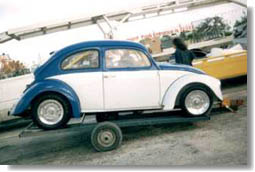|
|
|
 |
| MEMBERS' CARS |
|
Feature
Date: November/December 1998
|
 Hot
Bug Hot
Bug
Owner: John Drury John Drury’s is a name which is familiar to many a motorist in Malta, not only because of the engineering firm he runs in Gzira, but also because of his adventures in the local racing scene. For John has been actively racing since he ‘got his licence’. Now he is achieving further success on the local drag-racing scene by means of a VW Beetle which he has personally prepared for the purpose. Id-Drury’s earlier racing experience followed the now well trodden path along Armier and Plam Beach in a Mini Cooper 1000 and various Spitfires. He later joined the Ford Escort bandwagon in both drag-racing and hill climbs but now, having hung up his helmet and gloves, John has opted to keep his hands in by preparing a car to beat the Escorts in drag racing. And to do this, he chose an early sixties VW Beetle. Asked how he came to choose a car which, we must admit, does not enjoy such a good reputation for sheer straight line speed, at least locally, John readily replied that he always liked the cars and, having read so much about their successes abroad, decided to follow along these lines.
The body had to be extensively repaired to reduce the rust bug that had firmly taken hold but, instead of following the easier and lighter route offered by fibre glass, John chose to weld in as much new metal as necessary. In fact, besides new floor pan halves and strengthened sills, the beetle has also been equipped with a seven point roll cage, manufactured by John himself, just to add some more strength into the body shell. Further safety is provided by the four-point seat belt which keeps the driver tightly strapped during the nightmare drive down the quarter mile. The car’s body is otherwise standard, except for two metal front mudguards with upright headlamp bowls and fibre mudguards on the rear. In fact, it still retains the original dashboard, which does not include a fuel gauge, as well as the semaphore blanking plates which are so well made that John feels these must have been factory made. The rear, or rather the business end of the car, has been modified to accommodate a ‘slightly’ bigger engine than originally carried. In fact, the inner wheel arches around the engine bay have been cut back to give more space and a better air flow around the otherwise uncooled engine. As stated above, the rear mudguards are in fibre-glass as these had to be wider than the originals to accommodate the 8-inch Firestones that cover the rear wheels. The rear engine shroud is also non-original and is held in place by four Dzuz fasteners. The bonnets, that is both the ‘traditional’ one in front as well as the actual engine cover at the rear of the beetle are standard metal items, although the one at the back comes from a 12-volt vehicle.
The engine is built around a 1300 cc crankcase which was bored out to accept the 94 bore x 86 stroke cylinders that John chose. These are topped by twin port cylinder heads, especially manufactured for drag racing. Fuel is delivered by an electric fuel pump to two twin-choke 48IDA Webers and the all essential spark is provided by an electronic ignition system. The C12 racing fuel is let into the engine via 48 mm inlet valves whilst the exhaust gases are expelled through 38 mm valves into a two inch exhaust system, which was also made by John himself. The valves are operated by an Engel cam via original style pushrod tubes. The engine is closely monitored via an oil temperature and pressure gauge, a cylinder head temperature gauge, which all adorn the otherwise bare dashboard, as well as various sensors including one in the exhaust system that feed the engine management control box.
As one may very well imagine, this is one hell of a beetle, capable of moving at speeds which are far removed from those possible when it was new. In fact, it has been clocked at 118 mph, covering the quarter mile distance in 11.2 secs. On its first outing, the car managed a second place in the PS/CA category in which it races but this was only because it was still being sorted out. Since then, it has achieved three first places and John feels he can still extract some improvements. Has John ever savoured the sheer power that this car produces when driven in anger? The answer is no, for nowadays John derives his pleasure by preparing the car and watching it point its 4-inch front wheels towards the sky on its way to further glories.
|
|
|
 |
|
|